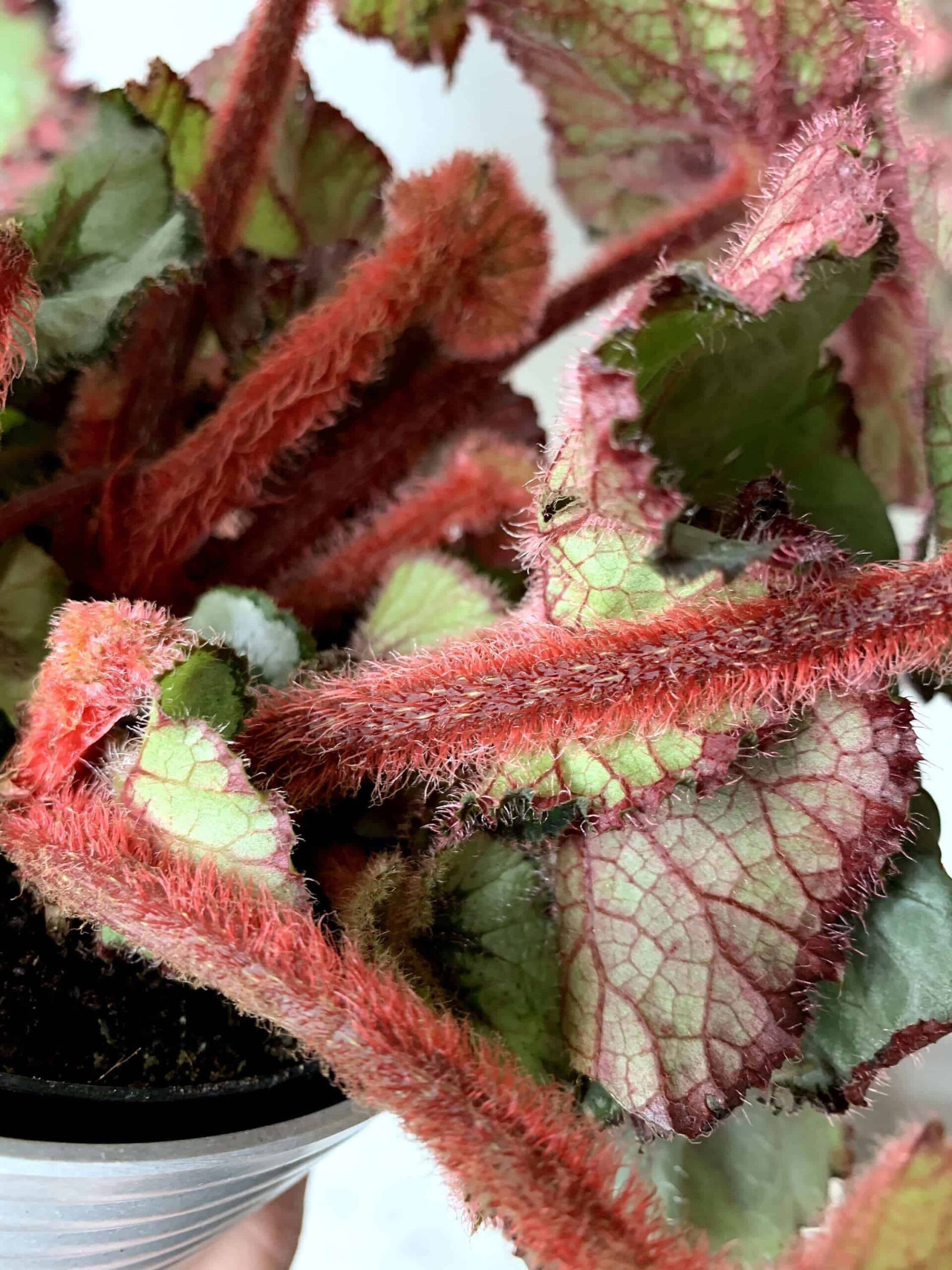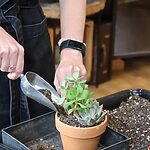All About Begonia
It’s safe to say that all indoor Begonias fall into the category of weird and wonderful houseplants. Belonging to the Begoniaceae family, this genus of perennial flowering plants boasts 2002 different plant species. The vibrant array of species can be found in moist tropical and subtropical climates scattered across south and central America, Africa, and southern Asia. They come in many different shapes and sizes with strikingly coloured foliage and a gorgeous array of leaf forms.
It is hard not to fall in love with Begonias! But tread carefully if you are a new houseplant custodian.
Begonias like what they like and in most cases are unwilling to settle for less. If not cared for properly, they will not hesitate to show you that they are unhappy. But provide them with the care outlined below and they will reward you with endless beauty all year round.
Light
Finding ideal light conditions may take a little bit of figuring out. It’s always a bonus to know and understand the orientation of your home and have a good idea of how the light flows through.
Almost all Begonias will need bright indirect light. This will be essential to keeping those beautiful vivid colours. Where some species will tolerate a small amount of direct morning light others couldn’t imagine anything worse. Understanding where your choice of Begonia sits on the scale will help you to provide the perfect spot.
Humidity
Humidity can prove troublesome and is very dependent on your home. It’s common to have varying levels of humidity that will change throughout the year depending on the season. It is highly recommendable for any houseplant collector to invest in a humidity and temperature gauge to help when picking the ideal spot.
When caring for a Begonia, it’s important to consider their native habitat as these will be the ideal conditions for your plant to thrive. Begonias will need relatively high humidity almost all year round (50-90%) but it is crucial to recreating this atmosphere in the correct way.
Top Tip
AVOID SPRAYING WITH A MISTER!
A lot of indoor Begonias are covered in small hair-like fibres that trap tiny droplets of water on the leaf’s surface. This drastically reduces airflow to the surface of the plant and can result in powdery mildew and fungal infections if not dried out quickly enough.
The average home has a humidity level of 40% and most Begonias will tolerate this. But keep a close eye on stress signals from your plant. If you cannot figure out why your plant is struggling, it may be time to consider its humidity levels. This can affect plants much quicker in the winter when the central heating is fired up and removes all of the precious moisture out of the air.
The best way to maintain high humidity is to use a humidifier placed about a metre away from your plant (so droplets do not form on the leaves) to provide high ambient humidity.
Alternatively, you could place your plant on an undertray filled with clay pebbles or small stones that are sitting in a shallow layer of water. Make sure the plant is not submerged in any water as this can lead to root rot.
As the water from the undertray evaporates from the surface of the pebbles or stones it will keep humidity levels high exactly where you need it most.
Water
Watering Begonias can be difficult. The number one killer for these plants is too much water. There is a fine balance between keeping the soil damp rather than wet and then allowing enough time for the soil to dry out.
There will also be factors within your home that will contribute to how quickly your plant will dry out. This means that watering can be very subjective depending on the location within your home. For example, if it’s in a dry environment e.g. next to a radiator, it is likely to dry out quicker than if it was placed in a nice, humid bathroom.
Top Tip
Always water from the base of the plant. Sitting your plant in an under tray and allowing it to absorb water from the base will reduce the risk of getting water on the foliage and is a good preventative measure for fungus gnats.
Pro Tip
Before you water your plant, take note of the weight of the pot. Once you’ve watered the plant, try to notice the difference in weight from before. Now you can quickly tell if your plant needs water by just lifting it up.
Soil
Begonias require free-draining and airy soil. They like to have a bit of space around their root for maxim airflow.
Most houseplant composts will do the job. However, you can further increase the aeration of the soil by adding perlite to your mix. In my experience, a ratio of 4:1, 4 parts houseplant mix to 1 part perlite, works wonders.
Did you know we make our very own houseplant potting mix? Check it out here!
Top Tip
If you don’t have any perlite handy, you could use horticultural grit or orchid bark.
Pests & Disease
Pests are the bain of all houseplant lovers’ lives. They seemingly appear out of nowhere and proceed to sap all the goodness out of our leafy friends.
Unfortunately, this is no different with Begonias. It is good practice to regularly check your plants for any signs of aphids, red spider mites, mealy bugs, and thrips. You may notice some signs of distress and allow yourself time to prevent a full-blown attack.
With Begonias being such lovers of humidity this can leave them susceptible to powdery mildew and fungal issues. These will mainly occur if they have been overwatered, leaves misted, or if they have not been able to dry out in time. Powdery mildew is an easy problem to spot, it stands out very clearly on the bright foliage. But the fungal issues will generally lead to leaf curl and yellow/brown spotting. To treat powdery mildew, prune away the affected leaves and keep the plant in a room with a stable temperature and humidity. If the problem persists, treat with a suitable fungicide.
Feed
Begonias prefer high potassium plant food. This will help to build stronger plant cells, allowing the plant to withstand stress much more effectively. This will help give your plant the best chance to thrive!
Repotting
The appropriate pot size will depend on the variety of your Begonia. The two main types of houseplant Begonias are;
Crane Stem, otherwise known as the Angel Wing variety, has much more fibrous roots and will prefer deeper pots so they have space to extend their root system.
Rhizomatous Begonias, for example, Rex Begonias, grow from horizontal rhizomes under the soil instead of a normal root system. When repotting this variety it is better to use a wide and slightly shallower pot to allow the rhizome to grow on its horizontal trajectory.
Go and check out our awesome range of pots to find a new home for your leafy friend!
Troubleshooting & Tips
- Good air circulation will help to keep your begonia happy and healthy.
- Provide a minimum temperature of 13°c in the winter ideally the higher the better but if you can maintain a constant 13°c it will survive.
- Brown edges can be caused by low humidity, too much direct heat, or temperature fluctuations. Time to change the location to somewhere more suitable.
- Leaf drop is often the result of low light levels, overwatering, underwatering, too much humidity, or a lack of airflow. Time to review your watering and care schedule or maybe try a better location.
- Yellow halos on the leaves are signs of leaf spots. This occurs in a moist and cool environment. Any affected leaves should be cut off and the plant should be moved to a warmer location with better airflow.
Toxicity
This plant is toxic to both people and animals. While most of the highly toxic parts are safely under the soil, ingesting the leaves can still cause you and your furry friend some trouble.
They contain a biochemical called Cucurbitacin B. When ingested symptoms can include a burning sensation in the throat, mouth, tongue, and lips; excessive drooling, swelling of the throat and difficulty swallowing. In some cases, these symptoms can continue for up to two weeks.
Species
Below is a list of some of the most popular Begonias on the market and often stocked in our shop.

Begonia Amphioxus
A small craned stem Begonia that is perfectly suited for terrariums. From Sabah, in Borneo, this exotic begonia has long-lanced and narrow-shaped leaves with large dark red spots that can grow up to 12 cm. Its ethereal appearance and love of high humidity make for a stunning choice in any closed terrarium.
Head Over To The Shop To Grab Yours Now!
Check Out How To Build Your Own Begonia Terrarium
Did you know we also make Handmade Bio-Active Terrarium?
Begonia Benigo Pink Polka Dot
Another craned stemmed begonia with highly unusual dark textured foliage, which transitions through a spectrum of colours starting out as a light bronzy red before developing into a striking contrast of dark green and beautiful pink polka dots. It also boasts a red reverse side of the leaf and stunning dark red stems to make one very eye-catching plant.
Head Over To The Shop To Grab Yours Now!






Cissus Discolor (Vine Begonia)
It must be said that this plant isn’t actually a Begonia. Despite the similarities to the Rex Begonia, this plant is closely related to the grapevine (Vitis). But nonetheless, with its bright almost fluorescent silver variegation against the rich dark green leaves, it is easy to see why this has picked up the name Vine Begonia. With its exotic look, it makes a gorgeous alternative for a trailing plant.
Head Over To The Shop To Grab Yours Now!



Rex Begonia
A rhizomatous Begonia that in my opinion is one of the most striking houseplants in existence. Its large ovate leaves boast an unusual rainbow of colours. Often seen with metallic-like base colours complemented by deep reds, pinks and purples. This is a must-have for any colour lover.




If you enjoyed this guide head over to Articles & Blogs to learn more or check out our YouTube for even more useful information!













